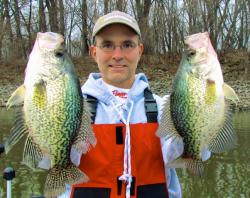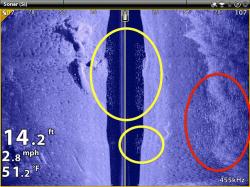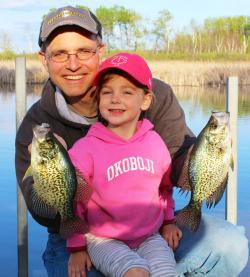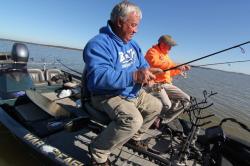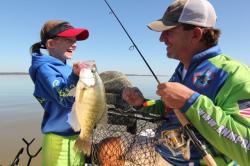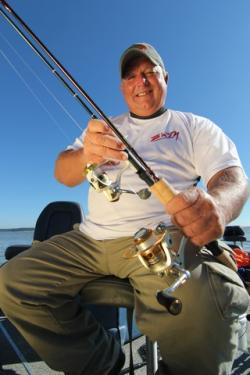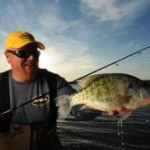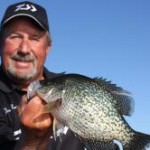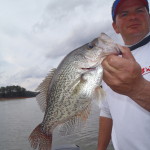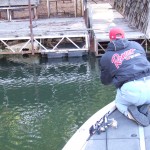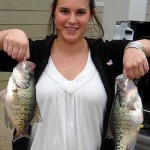Slab Crappie Time On Lanier
Lake Lanier is a 38,000 acre Corps of Engineers lake just north east of Atlanta. Since Atlanta draws much of its water supply from the lake, it has been in the news a lot the past year because of low water levels. It is also one of the most popular recreation lakes in the US.
Mention fishing at Lake Lanier and people immediately think of spotted bass and stripers. But the lake has an excellent population of crappie and a few fishermen have learned how to catch them. You can often catch 100 crappie a day at Lanier this spring and 200 fish days are possible.
Todd Goade lives in Buford and loves all kinds of fishing. Last year he finished third in the point standings on the Bulldog BFL Trail. He enjoys tournament fishing and when he is not fishing the BFL or another bass fishing trail he often will be catching crappie at Lanier.
Last spring he teamed up with Alan Gee to place second in the Crappie, USA tournament on Lanier. Todd and Alan fished the pro division and weighed in a seven crappie limit that weighed 9.83 pounds. Although they caught over 200 crappie that day, they did not catch the big fish that would have increased their weight. Catching and culling through 200 crappie is a fun way to spend a day on the lake.
There are several reasons Todd likes crappie fishing at Lanier. It is more relaxing than bass fishing so it is a nice change-up. The tackle is simple and easy to use. Crappie are excellent table fare and are hard to beat no matter how you cook them. And you can catch a lot of fish. Who wouldn’t like feeling a fish at the end of your line every few minutes.
Todd says there are a lot of pound to pound and a half crappie in Lanier but two pounders are hard to find. The Crappie, USA tournament results from last March bear this out. There were only five crappie brought to the scales weighing over two pounds and big fish for the day was a 2.31 pound fish. But who can complain about catching crappie that weigh over a pound each? And that is scale weight, not “guesstimate” weight.
Todd has learned how to catch Lanier’s crappie and the way he does it will work for you. Shooting docks with jigs is the way he likes to catch them. You will need a boat, light spinning rod and reel loaded with 4# test line and a couple of cards of Hal Flies.
“In April it seems like every crappie in Lanier is under a dock,” Todd said. Since there are so many docks on the lake and so many crappie under them, targeting docks is definitely the way to go. And you can catch crappie under docks all year, not just in the spring.
Little River and Wahoo Creek are the areas Todd usually fishes, especially early in the spring. It is good year round but the water warms first further up the lake and those areas turn on first. Later in the spring the docks down the lake will be better as the water warms there. There is a little more color in the water further up and that causes it to warm faster.
Water with a little stain in it is good. Todd likes to be able to see his jig down a foot or two but no more. Stained water warms seems to make the fish hit a little better since they don’t get as good a look at the jig. You can catch fish from extremely clear water but a little stain will help you catch more. Muddy water is tougher, too, so try to find stained water.
Any dock on Lanier can hold crappie. Todd says you should start fishing an area and keep records and notes of where you catch good fish. He will often hit a bunch of docks in the morning then return to the ones where he caught fish later in the day.
Early in March the crappie are likely to be holding on deeper docks toward bigger water. Docks with at least 17 feet of water under them are best. As the spawning urge takes hold when the water starts to warm the crappie will move back into the docks in coves and pockets and will be under docks with as little as six or seven feet of water.
“The dogwoods bloom and the crappie spawn is the old saying,” Todd told me. When the water temperature is 62 to 64 degrees I expect most of the crappie to be back in pockets in shallow water spawning. But not all spawn at the same time. They move back in waves so you can find some fish in different depths most of the time.
By late April after spawning the fish will move back out, holding on the same docks they used as they moved in. And some docks will be “honey holes” and hold crappie better than others. Sometimes you can pick these docks out by looking at them but you usually have to fish to find them.
Covered docks are best and the more stuff overhead the better, according to Todd. Pontoon boats are especially good. Older docks seem to be better. A boathouse with a pontoon or boat lift under it can be excellent. Brush piles under and around the docks sweeten them, too.
Todd seldom fishes an open slip in a boat dock. Crappie want something over there heads and an empty slip is way too bright. If there is a brush pile under the slip it might be worth hitting but usually he just goes to the next slip where a boat or lift offers lots of cover over the fish.
Seeing green algae growing on boats, dock floats, posts and boat lifts means the dock is likely to be better. Baitfish feed on the algae and are attracted to docks with it. Crappie eat the baitfish so they are more likely to be under docks where there is a lot of food for them.
To shoot a jig under a dock you need a five to five and a half foot spinning rod with a light tip. Todd likes an All American 5.5 foot rod and teams it with a small Pflueger President reel. The reel needs a smooth drag and the small spool helps the line come off faster.
The line is very important and Todd chooses 4# test Trilene Fluorocarbon Professional Grade. This line is tough for its size, invisible in the water and works well on his spinning reel. A limp line is necessary for small reels and thin line helps the light jigs sink better.
Todd uses Hal Flies for all his crappie fishing. He likes the 1/24 ounce jig best and he starts with a white or white and chartreuse jig. One with some pink in it is good in clear water, too. Many colors work well and some jigs with reds and yellows attract bites, especially if there is a little color to the water.
Hal Flies have feather tails and Todd bites off a little of the end of them, making them just a bit shorter. He says he is not positive this helps him get more hits but he does it anyway. It is worth trying, especially if the fishing is tough. You never know what might help.
Quietly approach a dock you want to shoot and get in close. Your boat will usually be just a few feet from your target. Kneeling or even sitting on the boat deck helps you get on the right level to shoot under the dock. A quiet trolling motor is best and Todd often uses his hand to move the foot control to position the boat. If you are in the back of the boat you can often just sit on the deck and stay in the right position for shooting the dock.
Boat position can be critical. Sometimes fish seem to want the lure moving in a certain direction, especially if they are holding on a brush pile right in front of the dock. Experiment with different angles and let the fish tell you what they want.
The bigger crappie usually hold in the hardest area of the dock to get your jig into. A narrow opening between dock floats and a boat lift float or pontoon float may mean you have to hit a six inch wide, four inch high hole, and you need your jig to go as far back as possible. Remember, the more stuff overhead the more likely the crappie are to be there, and the further back and darker the spot the more likely bigger crappie are to be holding.
Open the bail on your reel and drop your jig down to the last guide above the reel. Grab the head of the jig between thumb and trigger finger with your free hand. While holding the line at the reel with your finger, pull the tip of the rod down to make it bow. Aim the rod at the opening you want to hit and release the jig. As it flies toward the target, release the line at the reel.
It takes some practice to do this but is easier than it sounds. You will go high and hit the dock or go low and hit the water too soon but a little practice will have you putting your jig in spots impossible to reach any other way. Sometimes your jig will skip on the water and you can get it even further back, especially if there is not much clearance between the water and the top of the gap you are shooting.
When your jig hit’s the water flip your bail shut and count the jig down. A 1/24 ounce jig on 4# line will sink about a foot a second. Todd says he counts “One Mississippi, Two Mississippi” to keep a consistent space on his count. You need to know the depth your jig is at when you start getting bites.
Start by counting down to six and then slowly reel your jig back. No action is needed on the retrieve. Actually, jiggling your rod tip may hurt the chances of a bite. If you have ever watched a small minnow swim along it does not move much, it just glides along. That is what you want your jig to do.
Try a few shots with a six count then try eight, ten and even 12 counts. Watch your line carefully at all times. If it jumps as the jig sinks, set the hook and reel in the fish. Just remember where it was on the strike and start using that count. Crappie usually hold at about the same depth on most docks.
When Todd fishes with a partner they try different counts with one reeling in at six and the other at ten then both changing. That way they can cover different depths quickly. They will also try different colors. Once the fish tell them what depth they are holding and which color they like best both will concentrate on those keys.
Another trick Todd uses is to let his jig fall an few inches just when it passes the end of the float or edge of the boat he is fishing. Sometimes a crappie will follow the jig and that little drop will trigger a hit.
As you reel in watch your line, too. If it jumps or if you just feel it get heavy, set the hook. Don’t use a break-their-jaw hook set, just sweep the rod tip and the light wire hook in the jig will go into the soft mouth of the crappie.
Play the fish slowly and carefully to the boat. Crappie aren’t called “paper mouth” for nothing. It is easy to pull a hook out of a big fish, even with four pound line. And you don’t want to break the light line.
Often you will shoot over a bar or part of the dock under water. When you hook a crappie with your line over something, go to it with the boat and get it. You can not pull a decent fish over anything with such light line.
Some people worry about getting a hook in their finger while shooting a dock. Todd says that has never happened to him. Holding the jig by the head turns the hook up and away from your fingers so it will not hook you when you release it. And it won’t come flying back at you if you try to pull it loose if it gets hung. Four pound line will almost always break before that happens.
Todd will shoot his jig into openings on a small dock seven or eight times then move on. He tries a few shots at different depths but says crappie usually hit pretty quickly if they are there. There is no need to waste a lot of time if you are not getting bit. But if you do catch one fish you are likely to catch several.
Don’t hesitate to go back to docks where you caught fish earlier. Crappie will often move in and out around the dock and will be easier to catch at different times. And Todd says watch your depth finder. You will often see a school of crappie near a dock, or brush out from it. When you spot either back off and work your jig through that area at different depths.
Schools of crappie often look like balls of baitfish on your depth finder they are so close together. Baitfish may be present, too, and that is a good sign. Always keep an eye on what is under the front of your boat.
Bass boats are fine for shooting docks but their high decks are a drawback. A lower, smaller boat allows you to get down to the water level easier and make better shots under docks. If you are in a small boat just put in near where you want to fish since Lanier can get so rough.
If you want to try your luck in a crappie tournament, Crappie USA has a tournament on Lanier on March 15, 2008 and West Point on March 29, 2008. There is also a tournament on Weiss on March 8, 2008 and Hartwell on April 5, 2008. You can enter the Amateur Division for a $75 per team fee or choose the Semi-Pro Division at a higher cost. Cash prizes are paid in each division but are higher in the Semi-Pro side.
Crappie, USA was formed in 1996 and purchased the “Crappiethon” tournament trail. They hold 45 tournaments in 20 states each year. Each region has at least six spring and two fall tournaments. The Georgia tournament last fall was on Oconee.
To fish in their tournaments you must join their American Crappie Association organization for a cost of $25 per year. You can get more information about Crappie, USA and their tournaments at http://www.crappieusa.com/
